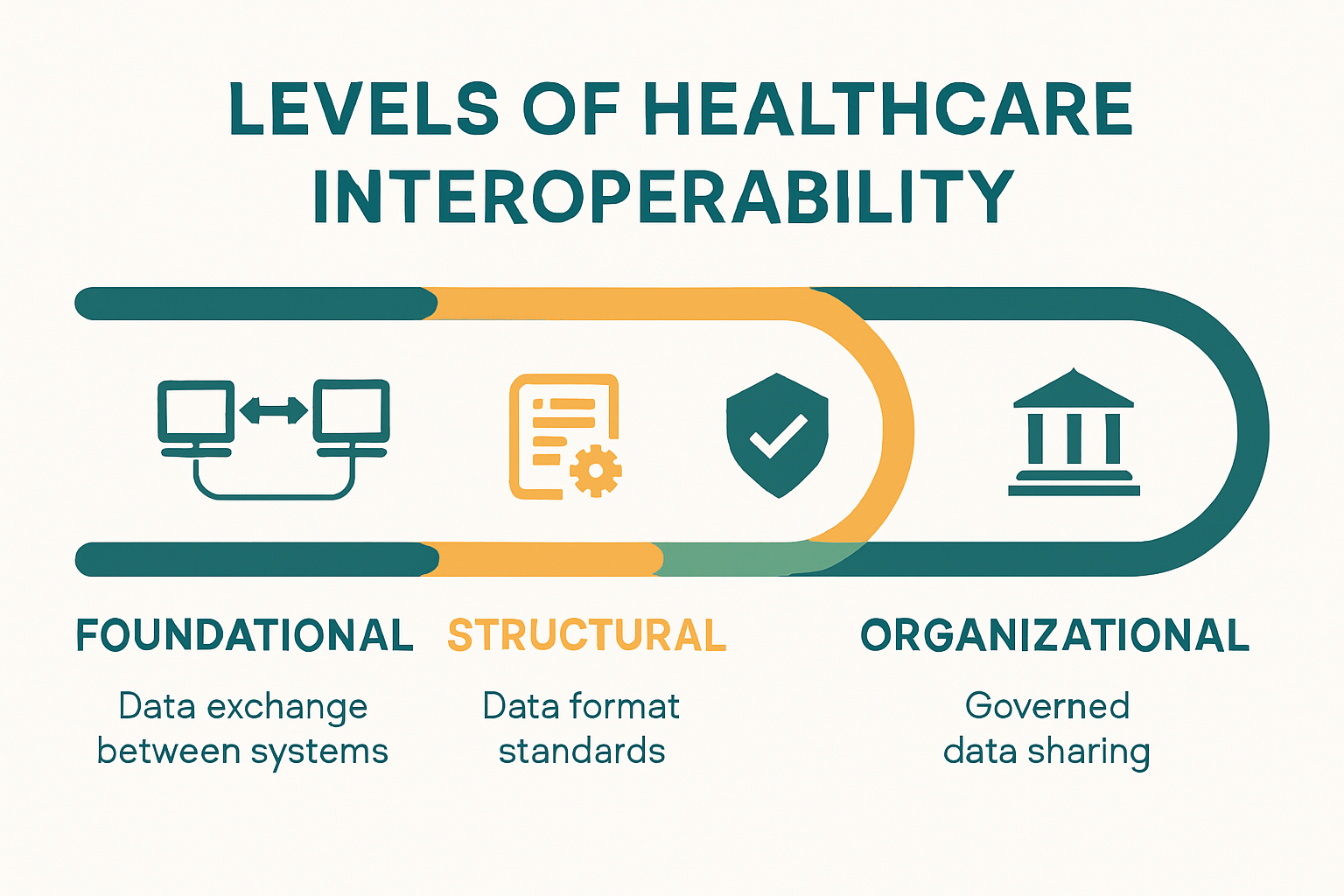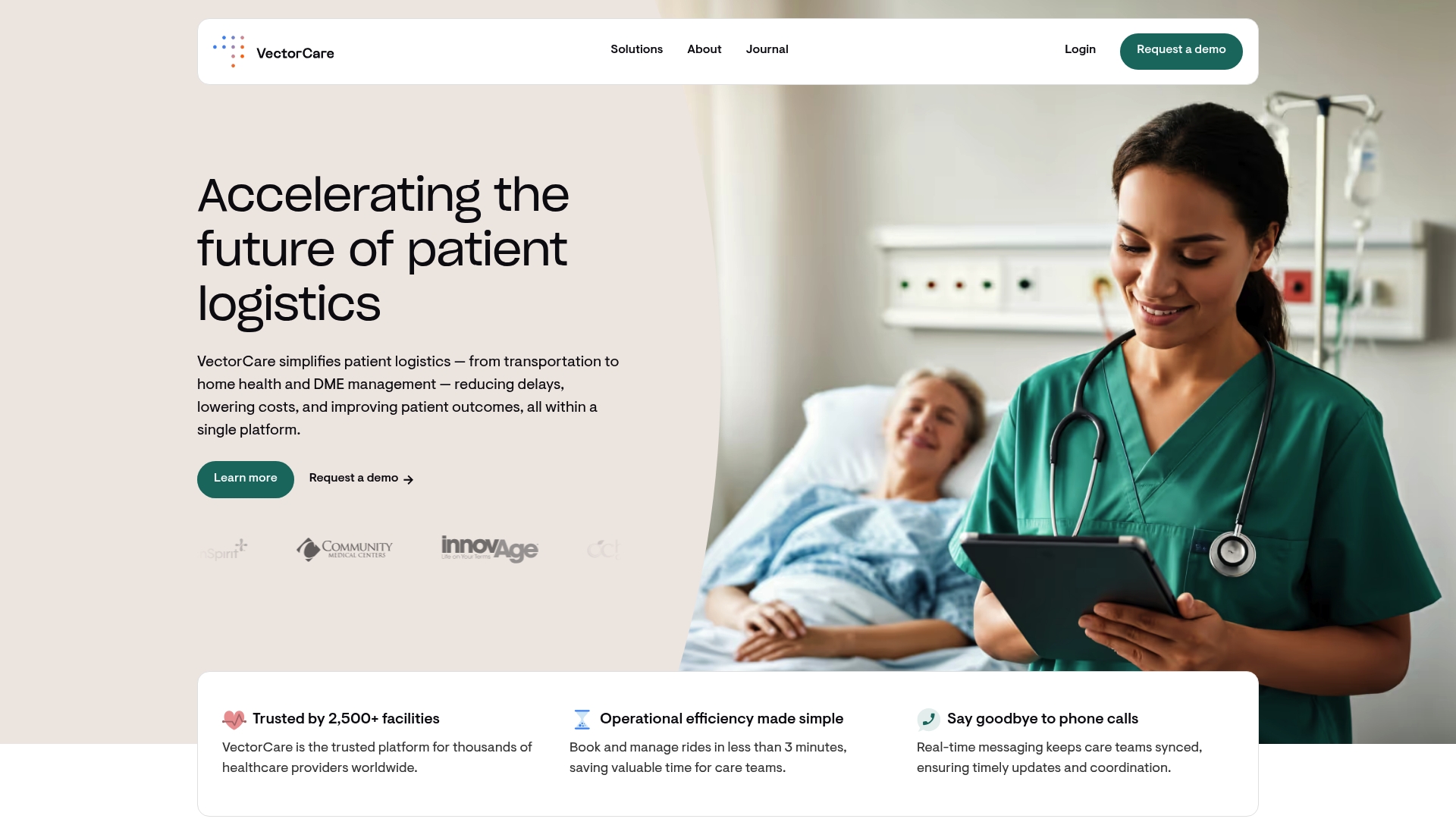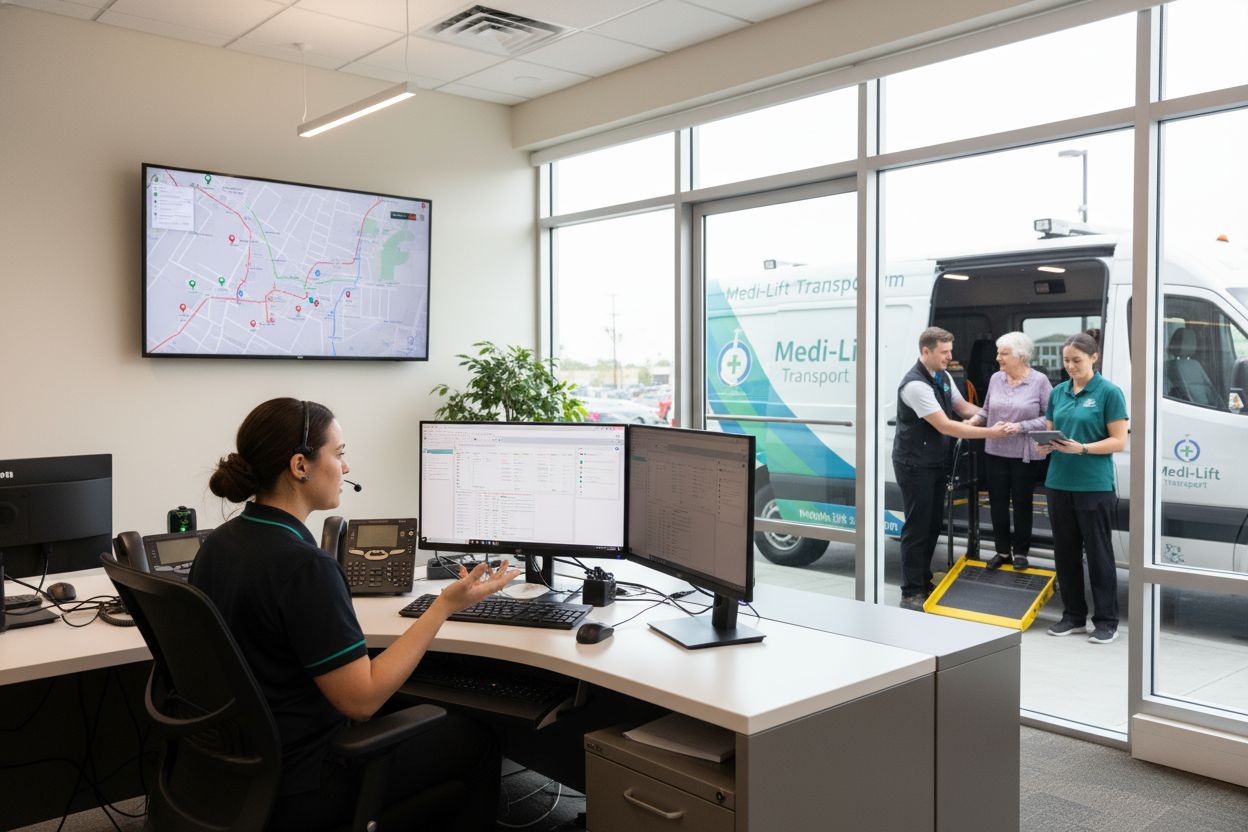Interoperability in Healthcare: Key Insights for 2025

Healthcare systems are racing to share patient information faster and more accurately than ever before. But despite all the hype about digital records and smart devices, only about 30 percent of hospitals actually report achieving full interoperability right now. This is surprising because clunky technology is not the biggest obstacle anymore. The hidden hurdles are tangled regulations, outdated infrastructure, and even resistance from inside organizations themselves.
Table of Contents
- What Is Interoperability In Healthcare Today
- Main Challenges In Healthcare Interoperability
- Benefits For Providers, Agencies, And Payers
- Future Trends And Solutions For 2025
Quick Summary
| Takeaway | Explanation |
|---|---|
| Interoperability enhances patient care quality. | Seamless data exchange reduces errors, enables personalized treatment, and speeds up diagnoses, ultimately improving patient outcomes. |
| Technological challenges hinder interoperability. | Issues like incompatible data formats and legacy systems create barriers to effective communication between healthcare entities. |
| Regulatory frameworks shape data sharing processes. | Compliance with laws like HIPAA complicates data exchange, requiring organizations to balance access with patient privacy. |
| Investment in interoperability drives operational efficiency. | Organizations that allocate resources for technology upgrades will reduce administrative burdens and enhance care coordination. |
| Future trends lean towards collaborative models. | Emerging strategies will focus on cross-sector integration and patient-centric platforms, emphasizing holistic healthcare delivery systems. |
What Is Interoperability in Healthcare Today
Healthcare data exchange represents a critical frontier in modern medical technology, fundamentally transforming how patient information moves across complex healthcare ecosystems. Exploring healthcare communication solutions requires understanding the nuanced landscape of interoperability.
Defining Interoperability in Modern Healthcare
Interoperability represents the seamless ability of different healthcare information systems, devices, and applications to communicate, exchange, and utilize data cooperatively. According to the Office of the National Coordinator for Health Information Technology, this means creating a dynamic framework where disparate systems can connect and share critical patient information across organizational boundaries.
The core objective of healthcare interoperability goes beyond simple data transmission. It involves creating meaningful, actionable insights that enable healthcare providers to make informed decisions quickly and efficiently. The National Library of Medicine outlines four distinct levels of interoperability that illustrate the complexity of this technological challenge:

- Foundational Interoperability: The most basic level where one system can send data to another without requiring the receiving system to interpret the information
- Structural Interoperability: Defines the format, syntax, and organization of data exchange
- Semantic Interoperability: Enables different systems to not just exchange data, but comprehend and use the information effectively
- Organizational Interoperability: Addresses governance, legal, and policy considerations that enable secure, authorized data sharing
Here is a table summarizing the four levels of interoperability, their definitions, and roles in healthcare data exchange:
| Level | Description | Role in Healthcare Data Exchange |
|---|---|---|
| Foundational Interoperability | Allows one system to send data to another without need for interpretation by receiving system | Basic data transfer between systems |
| Structural Interoperability | Defines format, syntax, and organization of exchanged data | Ensures consistent structure and organization |
| Semantic Interoperability | Enables systems to exchange, comprehend, and use data effectively | Shared understanding of meaning across systems |
| Organizational Interoperability | Involves governance, policy, and legal aspects for secure, authorized data sharing | Enables secure exchange across organizations |
Technological Challenges and Patient Care Impact
Healthcare interoperability confronts significant technological and procedural barriers. The Centers for Disease Control and Prevention emphasizes that effective data exchange requires systems to communicate using standardized languages and protocols. These challenges are not merely technical but encompass privacy regulations, diverse software architectures, and the complex ecosystem of healthcare providers.
The real-world implications of interoperability extend far beyond technical specifications. When healthcare systems can effectively share patient data, the potential benefits are profound: reduced medical errors, faster diagnosis, more personalized treatment plans, and improved patient outcomes. Imagine a scenario where an emergency room physician can instantly access a patient’s complete medical history, allergies, and previous treatments from multiple healthcare providers, all with a few clicks.
As healthcare continues to evolve, interoperability will become increasingly crucial. The integration of electronic health records, telemedicine platforms, wearable health technologies, and advanced diagnostic tools demands a robust, flexible approach to data exchange. Healthcare organizations must invest in scalable, secure solutions that prioritize patient data privacy while enabling comprehensive, coordinated care.
Ultimately, interoperability is not just a technological challenge but a fundamental reimagining of how healthcare information can be shared, understood, and leveraged to improve patient care and medical decision making.
Main Challenges in Healthcare Interoperability
Healthcare interoperability confronts a complex landscape of technological, regulatory, and operational challenges that significantly impede seamless data exchange. Navigating healthcare communication barriers requires a comprehensive understanding of these multifaceted obstacles.
Technical and Infrastructural Barriers
The technical foundations of healthcare interoperability are fraught with complexity. According to research published in the Healthcare journal, healthcare organizations struggle with disparate and legacy systems that fundamentally resist standardized communication. These technological challenges manifest in several critical dimensions:
- Incompatible Data Formats: Different healthcare systems often use proprietary data structures that prevent straightforward information exchange
- Legacy System Limitations: Older technological infrastructures lack the flexibility to integrate with modern interoperability standards
- Inconsistent Implementation: Varying interpretations of technical standards create significant communication gaps
The Office of the National Coordinator for Health Information Technology emphasizes that these technical barriers are not merely isolated technical problems but represent systemic challenges requiring comprehensive strategic approaches.
Regulatory and Compliance Complexities
Healthcare interoperability exists within an intricate regulatory environment that adds layers of complexity to data exchange. Privacy regulations like HIPAA create necessary but challenging frameworks for secure information sharing. Healthcare organizations must navigate a delicate balance between comprehensive data access and stringent patient privacy protections.
The compliance landscape demands robust security protocols that can validate and authenticate data exchanges while maintaining patient confidentiality. This requires sophisticated technological solutions that can dynamically manage access permissions, encrypt sensitive information, and provide comprehensive audit trails of all data interactions.
Economic and Organizational Challenges
Beyond technical and regulatory hurdles, economic factors significantly impact healthcare interoperability. Implementing comprehensive interoperability solutions requires substantial financial investment. Healthcare organizations must allocate resources for technological upgrades, staff training, and ongoing system maintenance.
Small and medium-sized healthcare providers often find these investments particularly challenging. The cost of transitioning to fully interoperable systems can be prohibitively expensive, creating a digital divide that disadvantages smaller organizations and potentially compromising overall healthcare data ecosystem effectiveness.
Moreover, organizational culture plays a crucial role. Resistance to change, siloed departmental structures, and limited understanding of interoperability’s strategic importance can impede successful implementation. Healthcare leaders must cultivate a collaborative environment that views data exchange as a critical component of patient care rather than a purely technical exercise.
Addressing these challenges requires a holistic approach that combines technological innovation, regulatory adaptation, and organizational transformation. As healthcare continues to evolve, interoperability will become increasingly central to delivering efficient, patient-centered care.
Ultimately, overcoming these challenges is not just about technology but about reimagining how healthcare organizations collaborate, share information, and ultimately improve patient outcomes.
Below is a table summarizing the main types of challenges that hinder healthcare interoperability, along with specific examples from the article:
| Challenge Type | Example/Detail |
|---|---|
| Technical/Infrastructural | Incompatible data formats, legacy systems, inconsistent standards |
| Regulatory/Compliance | HIPAA requirements, privacy rules, secure data sharing protocols |
| Economic | Cost of upgrades, training, maintaining interoperable systems |
| Organizational | Resistance to change, siloed structures, lack of strategic vision |
Benefits for Providers, Agencies, and Payers
Healthcare interoperability represents a transformative approach to improving operational efficiency and patient care across multiple organizational types. Exploring innovative care coordination strategies reveals the profound impact of seamless data exchange.
Enhanced Clinical Decision Making
For healthcare providers, interoperability fundamentally transforms clinical decision-making processes. The National Center for Biotechnology Information highlights that comprehensive data exchange enables practitioners to construct a more holistic patient record, facilitating more informed and precise medical interventions.
Key advantages for providers include:
- Comprehensive Patient History: Instant access to complete medical records across different healthcare settings
- Reduced Diagnostic Errors: More accurate patient information leads to better diagnostic precision
- Streamlined Consultation: Faster sharing of critical patient information between specialists and primary care providers
Operational Efficiency for Agencies
Healthcare agencies stand to gain significant operational advantages through robust interoperability frameworks. The Centers for Medicare & Medicaid Services emphasizes that electronic data exchange can dramatically reduce administrative burdens, particularly in complex processes like prior authorization and patient referrals.
Agencies can experience transformative benefits such as:
- Reduced Administrative Overhead: Minimized manual data entry and paperwork
- Improved Resource Allocation: More efficient tracking of patient care and resource utilization
- Enhanced Compliance Management: Better tracking and reporting of regulatory requirements
Strategic Advantages for Payers
Healthcare payers encounter unique challenges in claims processing, patient management, and cost control. Advanced patient outcome tools demonstrate how interoperability can revolutionize insurance and healthcare management approaches.
Payers can leverage interoperability to:

- Optimize Claims Processing: Faster, more accurate claims evaluation
- Implement Proactive Care Strategies: Better insights into patient health trends
- Reduce Unnecessary Medical Expenses: More precise intervention and prevention strategies
The economic implications of healthcare interoperability extend beyond immediate operational improvements. By creating more transparent, efficient communication channels, organizations can significantly reduce systemic inefficiencies that traditionally consume substantial financial and human resources.
Moreover, interoperability supports a more patient-centric healthcare ecosystem. When providers, agencies, and payers can seamlessly share and interpret data, patients experience more coordinated, personalized care experiences. This holistic approach not only improves individual patient outcomes but also contributes to broader public health management strategies.
As healthcare technology continues to evolve, interoperability will become increasingly crucial. Organizations that invest in robust, flexible data exchange systems will be better positioned to adapt to emerging healthcare challenges, technological innovations, and changing patient expectations.
Ultimately, the benefits of interoperability transcend organizational boundaries, representing a fundamental reimagining of how healthcare stakeholders can collaborate to deliver more effective, efficient, and compassionate care.
Here is a table summarizing the unique key benefits of interoperability for each healthcare stakeholder group discussed in the article:
| Stakeholder | Key Benefits |
|---|---|
| Providers | Holistic patient records, fewer errors, faster consultations |
| Agencies | Reduced admin burden, efficient resource use, easier compliance |
| Payers | Faster claims, proactive care, lower costs |
Future Trends and Solutions for 2025
Healthcare interoperability is poised for transformative changes in 2025, driven by technological innovation, regulatory evolution, and shifting patient expectations. Exploring emerging healthcare technology strategies reveals a landscape of unprecedented potential and complexity.
Technological Innovations Driving Interoperability
The Journal of Medical Internet Research predicts significant technological advancements that will reshape healthcare data exchange. Artificial intelligence and machine learning are expected to play pivotal roles in creating more intelligent, adaptive interoperability solutions.
Key technological trends include:
- Advanced AI-Powered Decision Support: Intelligent systems that can analyze complex medical data across multiple platforms
- Enhanced API Architectures: More robust and secure application programming interfaces enabling seamless data exchange
- Predictive Analytics: Sophisticated algorithms that can anticipate patient needs and healthcare resource allocation
Regulatory Frameworks and Patient Access
The US Government Accountability Office highlights the critical role of emerging regulatory frameworks in driving interoperability. The Trusted Exchange Framework and Common Agreement (TEFCA) represents a significant step toward standardizing data exchange across healthcare organizations.
Critical regulatory developments will focus on:
- Patient Data Access: Expanding patient rights to access and control their healthcare information
- Standardized Data Exchange Protocols: Creating uniform standards for cross-organizational data sharing
- Privacy and Security Enhancements: Developing more sophisticated protection mechanisms for sensitive health information
Emerging Ecosystem and Collaborative Models
Interoperability in 2025 will extend beyond traditional technological solutions, embracing more holistic, collaborative approaches to healthcare data management. Organizations will increasingly view data exchange as a strategic ecosystem rather than a technical challenge.
Emerging collaborative models will emphasize:
- Cross-Sector Data Integration: Breaking down silos between healthcare providers, insurers, and public health agencies
- Patient-Centric Platforms: Developing solutions that prioritize individual patient experiences and preferences
- Real-Time Health Information Networks: Creating dynamic, responsive healthcare communication systems
The future of healthcare interoperability represents more than technological advancement. It signifies a fundamental reimagining of how healthcare stakeholders collaborate, share information, and ultimately deliver patient care.
Healthcare organizations that successfully navigate these emerging trends will be positioned to provide more personalized, efficient, and responsive healthcare services. The convergence of technological innovation, regulatory support, and patient-centered design will drive unprecedented improvements in healthcare delivery and patient outcomes.
As we approach 2025, interoperability will no longer be an optional enhancement but a critical infrastructure for modern healthcare systems. The ability to seamlessly exchange, interpret, and leverage health data will distinguish leading healthcare organizations from their competitors.
Frequently Asked Questions
What is interoperability in healthcare?
Interoperability in healthcare refers to the ability of different healthcare information systems, devices, and applications to communicate and exchange data seamlessly, allowing for more coordinated and efficient patient care.
Why is interoperability important for patient care?
Interoperability enhances patient care by reducing errors, enabling personalized treatments, and speeding up diagnoses, ultimately improving patient outcomes and quality of care.
What are the main challenges to achieving interoperability in healthcare?
The main challenges include technical barriers like incompatible data formats and legacy systems, regulatory and compliance complexities related to privacy laws, and economic factors such as the high costs of technology upgrades and organizational resistance to change.
What future trends can we expect in healthcare interoperability by 2025?
By 2025, we can expect advancements in technological innovations like AI-assisted decision-making, enhanced regulatory frameworks promoting standardized data exchange, and the emergence of collaborative models that prioritize patient-centric data management.
Move Beyond Data Silos with Truly Connected Healthcare Logistics
Are incompatible systems and outdated workflows slowing down your care coordination? The article shows how technical and organizational barriers are still making it difficult for healthcare teams to achieve real interoperability. With rising patient expectations and stricter compliance standards, overcoming these obstacles is not just an IT concern. It directly affects operational costs, resource management, and patient outcomes. If your team struggles with manual scheduling, vendor silos, or spotty communication, the right platform can make a real difference.

See how VectorCare solves these challenges with a fully integrated, AI-powered platform. You get automated scheduling, real-time communication, and seamless data sharing between all your teams. Cut delays and administrative burden for patient transportation, equipment delivery, and home health services. Want to reduce errors and lower your costs while supporting better patient outcomes? Discover how VectorCare can help you streamline every step of your patient logistics. Act now to bring your healthcare operations in line with the top interoperability trends for 2025.
Recommended
- 2020 Healthcare Recap & Upcoming Care Trends – VectorCare
- Becker’s Healthcare Report: How VectorCare Solves Communication Gaps in Patient Transfers – VectorCare
- How Coordinated Platforms Can Unite Private and Public Interests to Support Community Care – VectorCare
- The Benefits of Agnostic Software in Hospital Patient Logistics – VectorCare


